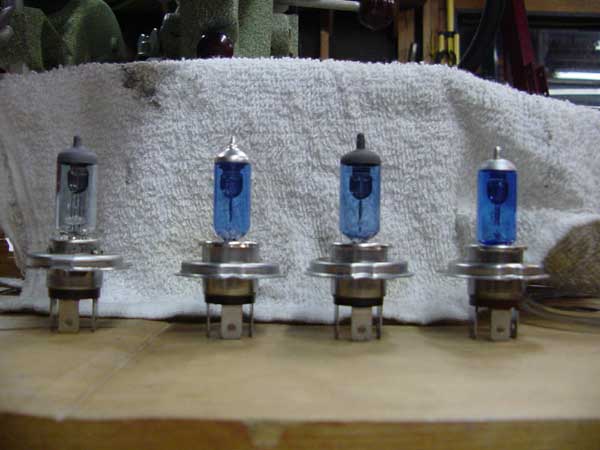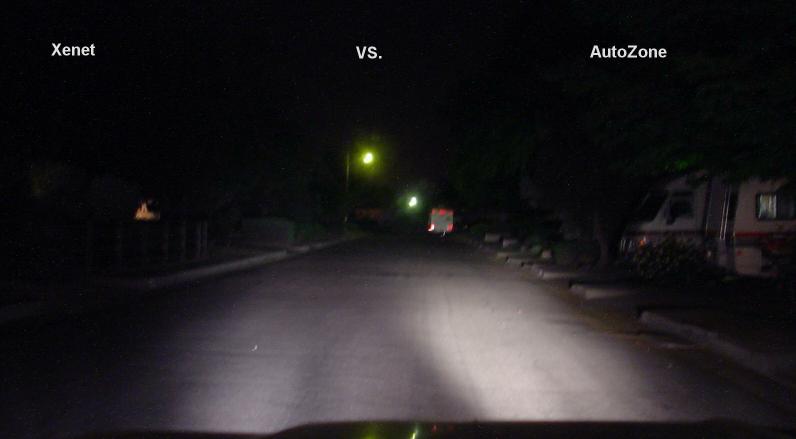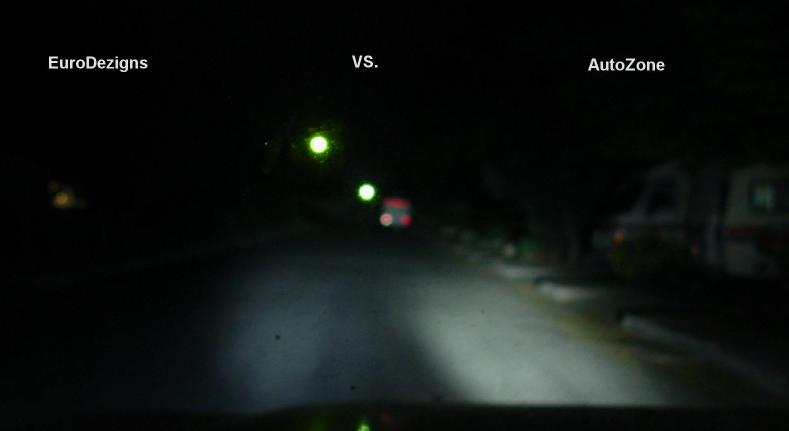
Here's my "headlamp test" page.

Hey everybody...I bet you're wondering why in the heck I would go through all the trouble of testing
headlamps at my own expense? Well, I'm glad you asked.
As some of you know, and others don't, I have logged many miles on my Harley - over 205,000 as of this writing. In that entire time I have never hit an animal on the open road. I have done many miles throughout Colorado and New Mexico, which are infested with deer and other quadrupeds, and have yet to hit one of them
With the recent onslaught of new and more-better (tm) headlight technology (Xenon gas, Metal-Halide, etc.), cheap, immitation lighting solutions have popped up all over the place. Fed up with the overabundance of hype and lack of available hard data (at the time of testing), I decided to simply bite the bullet, get on eBay, purchase 3 different brands of H4 lamps, and do side-by-side comparisons to the Sylvania H4's I've been using in all my vehicles for the past few years. Sylvania produces several models of H4 lamp. The model I use in all my vehicles is the "Cool Blue" lamps, which have been replaced with a newer model,
the Silverstar. The "Cool Blue" lamps (as well as the Silverstars) are filled with
Xenon gas
which gives them a hotter color temperature. To those not in-the-know, "hotter color temperature" means "Whiter" or "Bluer" light. Because of the "whiter" light, this translates to a brighter lamp (measured in lumens or candlepower).
Boring technical jargon and history lesson that you probably don't want to read...
In the automotive lighting arena, the hot ticket right now is Metal-Halide lamps, aka "HID" lights (High Intensity Discharge). If you've ever been driving down the road and noticed an approaching vehicle with extremely bright headlights with a bluish and/or purpleish hue, these are metal-halide lamps. If not aimed correctly, they can be extremely annoying. Fortunately these HID headlights produce a beam with a very visible border, which makes them extremely easy to aim. It's been my observation that these HID lights tend to be aimed correctly, unlike their halogen counterparts which seem to be aimed straight up into your face, especially on pickup trucks - God knows why. Is it really possible to drive with headlights aimed that high and not realize it???
Metal-halide technology has been around for quite a while, but because of the need for heavy ballasts and warm-up times of up to 2 minutes, they have been limited to mostly parking lot and warehouse lighting applications. Metal-halide is desireable in these applications because you get more than double the light output for the same energy consumption. If one multiplies many lamps times many hours, one could see the potential savings. As an example, I have both Metal-halide and halogen lamps in my back yard. The 1000 watt halogen lamp puts out roughly 20,000 lumens of light. Its metal-halide counterpart uses 400 watts of energy, yet puts out over 22,000 lumens of light. As one can see, you get more than double the lighting efficiency with metal-halide lamps than with halogen gas filled lamps. The reason I still have the halogen lamp in place is because the light is instant. Sometimes, if I'm in my back yard for only a minute or two, the halogen lamp is appropriate. If I'm going to be working on a project in the back yard for more than just a few minutes, I use the metal-halide lamp. Because of the warm-up time required by Metal-Halide lamps, they are always low-beam lamps and never high-beam lamps. High-beam lamps are used more intermittenly, hence the need for "instant" light. Though HID's are brighter, they take too long to warm up. I also read that the constant "on/off" duty cycle of a high-beam tends to be tough on the ballasts and the Metal-Halide lamps themselves.
Recent changes in technology have overcome the 2 minute warm-up period (though a few seconds of warm up is still required), however ballasts are still needed. Though metal-halide technology is available for your car or motorcycle (retrofit kits are available for almost any application), the cost of this technology is still very expensive - anywhere from $250.00 and up. This is more than most people are willing to pay for brighter headlights for their cars or motorcycles.
The alternate choice is Xenon gas-filled lamps which produce a whiter color temperature than halogen lamps, but not nearly as "hot" as the metal-halide lamp. The cost for a Xenon gas filled lamp is about 1/10 that of its metal-halide counterpart. In addition, non-HID Xenon lamps require no ballast, so the upgrade is as easy as changing the lamp ("bulb" in layman's terms). In some cases a new fixture is required, however even H4 fixtures are far less expensive than the metal-halide upgrade.
More boring technical jargon...
A typical metal-halide lamp has a color temperature of 4,000 to 5,600 degrees Kelvin (5600 degrees Kelvin is the color temperature of daylight). Xenon gas filled lamps, which have had claims of color temperatures in nearly the same range, in all reality, fall far short of 5600 degrees Kelvin. However some of the better, "legitimate" Xenon gas filled lamps do reach 4,000 degrees Kelvin (the Sylvania Silverstar, for example, claims a color temperature of 4,000 degrees). Any non-HID lamp claiming color temperatures higher than 4,000 degrees Kelvin are lying to you. In comparison, a Halogen lamp has a color temperature of 3,000 degrees Kelvin. The Sylvania "Cool Blue" lamps used in the test scenarios below claim a color temperature of 3500 degrees Kelvin.
The biggest problem with immitation HID lamps is that their "color temperature" has be altered through filterization. If you take a regular house lamp, throw a blue filter over it, you have changed the color temperature. Has the lamp become brighter? No. It has become "bluer." Because "color temperature" has become the new buzz word in the automotive lighting industry, manufacturers have played on the consumers' want for better lighting by advertising "hotter" headlamp temperatures. Though the claims of hotter color temperatures are mostly (but not all) true (because of the blue filter), lighting output is horribly dissappointing. The problem is that, since these companies are simply using a blue filter to achieve this bluer light, these lamps are not brighter, just bluer. As you can see in the picture at the top of this page, the lamps I purchased have been simply coated with a blueish tint. The lamp on the very left side is the Sylvania "Cool Blue" lamp. Real-world results are documented below.
Fixtures or "reflectors"....
I've used 4 brands of H4 reflectors; Cibie, Hella, Bosch, and a generic brand purchased at a Euro supply house. I like the beam that the Hellas and Boschs throw, however I have broken 2 Hella reflectors due to road pebbles. This is very disappointing since Hellas were not only the most expensive, but they're supposedly designed for off-road use. I didn't like the beam the Cibie threw. Like the generic reflector, the beam was very "dull;" absent of the distinct horizontal border we've come to know and trust in Hella and Bosch reflectors. So my recommendation is a Bosch reflector.
Don't be fooled....
My test was fairly simple. I left the existing Sylvania "Cool Blue" lamp in the passenger side fixture of my '76 F-150. This is a 55/60 lamp. Without getting overly technical, this means that the low beam is a 55 watt filament and the high beam is a 60 watt filament. I changed out the driver-side fixture with 3 different brands of H4 lamps purchased on eBay. Prices varied from $20.00 per pair down to as cheap as $5.00 per pair. Shockingly, some of these lamps were 90/100's (90 watt low beam and 100 watt high beam). Amazingly, even with the extra current draw, these lamps were still dimmer than the Sylvania. I contribute this to the blue coating "filtering" the lamp, thus robbing it of lumens. I believe I purchased my Sylvania lamps at a 2-for-1 sale at Autozone, so I paid roughly 10 bucks per Sylvania H4 lamp. Below are unretouched pictures of different lamp configurations in the high-beam position. I apologize for the blurry pictures.
As you can see the results are very dramatic and pretty conclusive. Don't waste your money on H4 lamps with claims of color temperatures in the 4800-8000 degree Kelvin range - 8000 degrees Kelvin...that's funny. They're a complete waste of money. Their claims are completely false. Go to Autozone and purchase a true Sylvania "Cool Blue" Xenon gas filled lamp. Sylvania "Cool Blue" lamps have worked best for me. I've yet to burn one out. Please take note of the new data below concerning Sylvania "Silverstar" lamps.
After only 90 days of use, the Silverstar lamp installed in my 1989 FXR Harley-Davidson burned out. I have asked several fellow Harley riders about their experience with the Sylvania Silverstar lamps and they reported similar problems with the Silverstar. I installed a new Silverstar lamp in my Harley on July 22, 2005. We'll see how long this new lamp lasts. Based on this new data, I DO NOT recommend the purchase or installation of Sylvania Silverstar lamps. I will continue with my original recommendation of the Sylvania "Cool Blue" lamps. The Cool Blue lamps had been in my Harley for over 2 years before switching them out with the Silverstars.
This page is up as of April 9, 2005 - 2:20 AM. Updated April 21, 2005 - 9:30 PM
Comments? Corrections? Please
e'mail me to tell me about it.



![]() New test added!
New test added!
![]()
As you can see by the picture below, there's not much difference between the Silverstar and the Cool Blue. I did 3 basic tests, one of which is pictured below. The second test is the "white garage door" test, which seems to be a standard benchmark test on most websites. I took the picture, but in my opinion it wasn't worth wasting the extra bandwidth to post it. The beams looked identical - take my word for it.
The third test was to look at the headlights from down the street. Again, they looked almost identical. The Cool Blue lamp had a slightly bluer "tinge" to it. I say "tinge" and not "hue" because the blue looked like it could have been sprayed on the reflector with spray paint. The blue "tinge" doesn't have an HID look to it at all. I still maintain that the Sylvania Cool Blue is a good lamp - the best H4 you can buy, IMHO, but it's still not an HID lamp. I will say that the Silverstar is it's equal if not ever-so-slightly better. If you see a Cool Blue sitting next to a Silverstar in the store, my recommendation is, if there's any more than a $1.00 price difference between the two, buy the cheaper lamp.
![]() New information added!
New information added!
![]()


All pictures & material Copyright © 2005 Donnie Frank